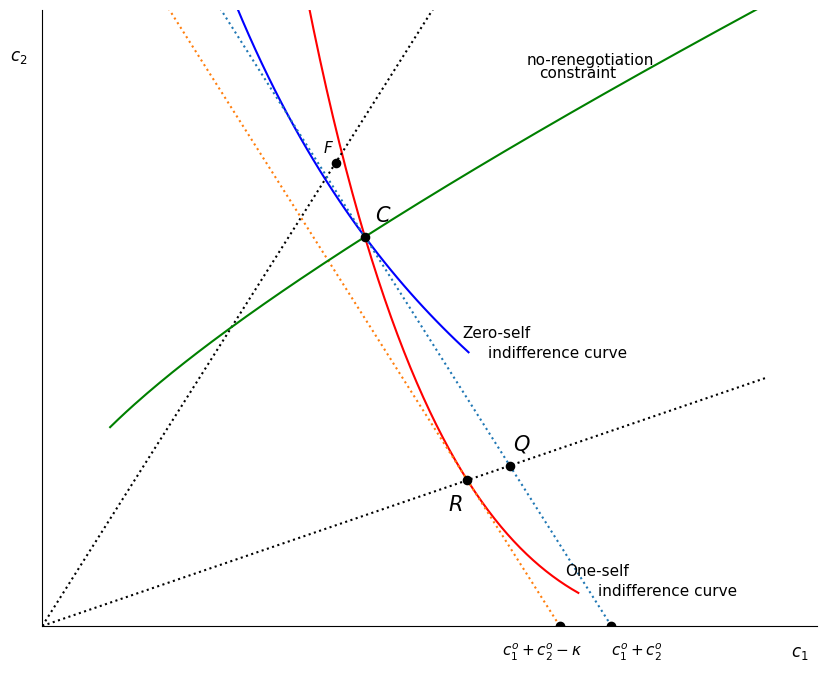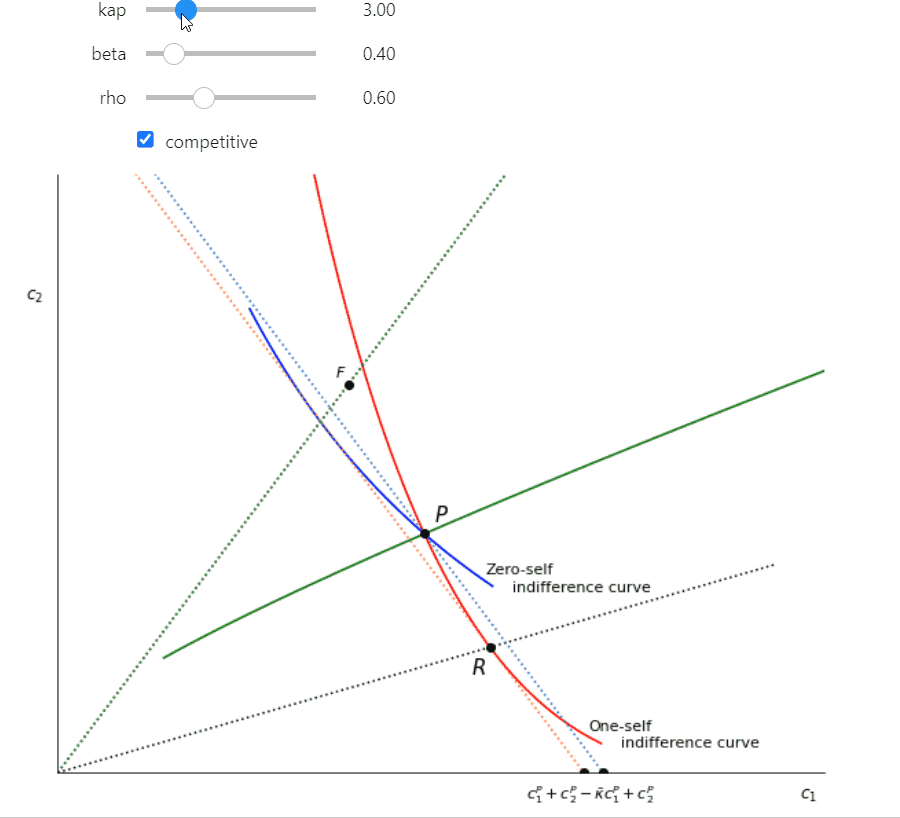Figure 2 Replication#
This page contains the code to replicate Figure 2 in the paper which shows period 1 and period 2 consumption levels under various possible contracts.
Code#
Several functions used can be found in the python module Contract.py
import Contract
Code below uses this module to produce Figure 2. If code is hidden in HTML view, click button to display.
import numpy as np
import matplotlib.pyplot as plt
from ipywidgets import interact,fixed
plt.rcParams['figure.figsize'] = 10, 8
np.set_printoptions(precision=2)
We have code that draws the main Figure 2 diagram for any (Competitive or Monoopoly) Contract instance C. This function by itself does not draw in the no-renegotiation constraint.
def Figure2(C, idlines = False):
cF = C.fcommit() # point F
cRP = C.reneg_proof() # point P
cR = C.reneg(cRP) # point R
btr = C.beta**(1/C.rho)
q1 = (cRP[1]+cRP[2])/(1+btr)
q2 = btr*q1
y = C.y
fig, ax = plt.subplots()
c1max = 120
c1 = np.arange(c1max)
ubar0 = C.PVU(cRP[1:3], 1.0)
id0 = C.indif(ubar0, 1.0)
ubar1 = C.PVU(cRP[1:3], C.beta)
id1 = C.indif(ubar1, C.beta)
#ubar0RP = cM.PVU(cCRP[1:3], 1.0)
#idc0RP = cM.indif(ubar0RP,1.0)
#ubar1RP = cC.PVU(cMRP[1:3], cC.beta)
#idc1RP = cM.indif(ubar1RP,cC.beta)
# contract points and coordinate lines http://bit.ly/1CaTMDX
xx = [cF[1], cRP[1], cR[1], q1]
yy = [cF[2], cRP[2], cR[2], q2]
ax.scatter(xx, yy, s=35, marker='o',color='k', zorder=10)
# indifference curves (slicing to clip indif curve lengths)
s0 = slice(int(cF[1])-15, int(cR[1])+2)
s1 = slice(int(cF[1])-7, int(cR[1])+19)
ax.plot(c1[s0], id0(c1[s0]), color='blue') # --Zeros's indif through F
ax.plot(c1[s1], id1(c1[s1]), color='red') # --One's indif through F
#plotpts(cF, cR, cRP)
# rays
ax.plot(c1[:85], c1[:85],':',color='black')
ax.plot(c1[:113], C.beta**(1/C.rho)*c1[:113],':',color='black')
# isoprofit line(s)
isoprofline = C.isoprofit(C.profit(cRP,C.y) - (y[0]-cRP[0]), y)
ax.plot(c1, isoprofline(c1),':' )
ax.text(c1[s0.stop]-2, id0(c1[s0.stop])+2, 'Zero-self', fontsize=11)
ax.text(c1[s0.stop]+2, id0(c1[s0.stop]), 'indifference curve', fontsize=11)
ax.text(c1[s1.stop]-3, id1(c1[s1.stop])+2, 'One-self', fontsize=11)
ax.text(c1[s1.stop]+2, id1(c1[s1.stop]), 'indifference curve', fontsize=11)
isoproflineK = C.isoprofit(C.profit(cRP,C.y)-(y[0]-cRP[0]) + C.kappa, y)
ax.plot(c1, isoproflineK(c1),':' )
# Axes
ax.set_xlim(0, c1max), ax.set_ylim(0, cF[1]+15)
ax.spines['right'].set_color('none'), ax.spines['top'].set_color('none')
ax.xaxis.tick_bottom(), ax.yaxis.tick_left()
ax.axes.get_xaxis().set_visible(False)
ax.axes.get_yaxis().set_visible(False)
ax.text(c1max-4, -3, '$c_{1}$', fontsize=12)
ax.text(-5, cF[1]+10, '$c_{2}$', fontsize=12)
ax.text(cF[1]-2, cF[2]+1, r'$F$', fontsize=11)
ax.text(cRP[1]+1.5, cRP[2]+1.5, r'$C$', fontsize=15)
ax.text(cR[1]-3, cR[2]-3, r'$R$', fontsize=15)
ax.text(q1+0.5, q2+1.5, r'$Q$', fontsize=15)
#-- Intercept points on y axis
ax.scatter(cRP[1]+cRP[2],0, marker='o',color='k', zorder=10)
ax.scatter(cRP[1]+cRP[2]- C.kappa, 0, marker='o',color='k', zorder=10)
ax.text(cRP[1]+cRP[2] , -3, r'$c_1^o+c_2^o$', fontsize=11)
ax.text(cRP[1] + cRP[2] - C.kappa - 9, -3, r'$c_1^o+c_2^o - \kappa$', fontsize=11)
A separate function nrpline(C) draws the no-renegotiation Constraint for contract C.
def nrpline(C):
'''plot points from C.rpc() along no renegotiation constraint '''
num = 150
beta, rho, btr, kap, _ = C.params()
c1rp, c2rp = np.zeros(num), np.zeros(num)
for i, s in enumerate(np.arange(30, 30+num)):
c1rp[i], c2rp[i] = C.rpc(s)
plt.plot(c1rp, c2rp, color='g')
plt.xlim(0,120), plt.ylim(0,C.fcommit()[1]+15)
plt.text(c1rp[90]+2, c2rp[120], 'no-renegotiation', fontsize=11)
plt.text(c1rp[90]+4, c2rp[115], 'constraint', fontsize=11)
plt.grid()
We wrap these two functions to have the option to plot them both, and later interactively set options.
Figure 2#
# Wrap Figure2 to allow passing parameters to interactive widget
def Fig2(kap=9, beta = 0.4, rho = 0.6, competitive = True, rpc = False):
if competitive:
C = Contract.Competitive(beta)
else:
C = Contract.Monopoly(beta)
C.rho = rho
C.kappa = kap
Figure2(C, idlines=False)
if rpc:
nrpline(C)
plt.savefig('Figure2.pdf')
Without a no-renegotiation line:
Fig2(kap= 8, beta = 0.4, rho = 0.6, competitive =True, rpc=True)

With the no-renegotiation line drawn in.
Fig2(kap= 8, beta = 0.4, rho = 0.6, competitive =True, rpc=True)

Interactive Plot#
In order for the widget sliders to affect the chart you must be running this on a jupyter notebooks server. If you are viewing this on the web, click on the Rocket icon button above to launch a cloud server service (Binder, or google colab).
The same diagram can display Monopoly or Competitive Contracts.
interact(Fig2, kap = (0,20,0.5), beta = (0.3, 0.95, 0.05), rho=(0.3,1.2,0.1) );
The parameters (\(\beta = 0.4\), \(\rho = 0.8\)) used were chosen to exagerate curvature and spacing for presentation clarity but the essential relationships hold for more reasonable assumptions. In the interactive further below you can vary the parameters yourself using sliders.
Gif#
In case you cannot run this notebook interactively, here is an animated gif showing how the position of the no-renegotiation constraint changes in response to changes in the value of \(\kappa\):



